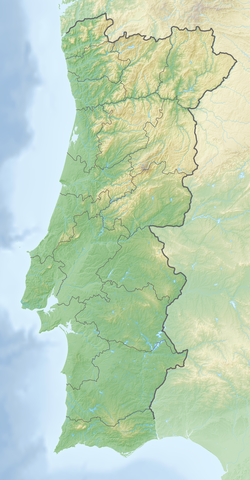Top Qs
Timeline
Chat
Perspective
Silveirinha Formation
Geologic formation in Portugal From Wikipedia, the free encyclopedia
Remove ads
The Silveirinha Formation is an Early Eocene (Ypresian, or MP7 or Neustrian in the ELMA classification) geologic formation of the Mondego Basin in the Região Centro of central-western Portugal. The sandstones, siltstones and conglomerates were deposited in an alluvial environment.[1]
The formation has provided fossils of many mammals, birds, amphibians and reptiles, as well as mollusks and ostracods, and is considered one of the richest Early Eocene faunal assemblages of Europe. The taeniodont, typically known as a North American order; Eurodon silveirinhensis and the ostracod Cypris silveirinhaensis have been named after the formation.
Remove ads
Description
The Silveirinha Formation, named after the Silveirinha clay pit, crops out in the western part of the Mondego Basin in the Região Centro of central-western Portugal.[2] The formation comprises fossiliferous lenticular calcitic conglomerates as well as laminated and cross bedded sands and brownish-red silts.[1]
The conglomerates are interpreted as crevasse-splay deposit in a alluvial plain environment, which eventually flooded and where bogs and possibly oxbows developed, crossed by channels depending on a river system that drained higher areas more north or eastwards.[3]
Climate
The climate in the Early Eocene was substantially warmer than today.
Remove ads
Paleontological significance
Summarize
Perspective
The Silveirinha clay pit after which the formation is named was first discovered in 1977 by Rui Pena dos Reis of Coimbra University.[4] The unit is one of few earliest Eocene fossiliferous formations that provided a rich amphibian and reptile fauna.[5] Most fossils were deposited in the channels after short transportation. Vegetation should have been rich in nearby areas, supporting a rich fauna. Ostracods, gastropods, amphibians and pelomedusid chelonians indicate fresh waters, although rare bivalves show that salt or at least brackish waters were not very far away.[3]
It is hypothesized that the species D. antunesi in the genus Diacodexis was more primitive than the earliest Wasatchian D. ilicis of North America, strongly supporting a Europe to America dispersal of this genus.[6]
Fossil content
The formation has provided the following fossils:[1]
Mammals
- Primates
- Arcius zbyszewskii[7]
- Donrussellia lusitanica[7]
- Acreodi
- Artiodactyls
- Carnivora
- Cimolesta
- Ilerdoryctes cf. sigei[11]
- "Condylartha"
- Ferae
- Glires
- Hyaenodonta
- Insectivora
- Russellmys denisae[7][17]
- Apatemys sp.[4]
- Heterohyus sp.[4]
- Perissodactyls
- Paschatherium marianae[7][18]
- Pliolophus vulpiceps[7]
- Teilhardimys reisi
- cf. Lophiaspis maurettei[11]
- Taeniodonta
- Theriiformes
- Archaeonycteris praecursor[20]
- Leptacodon nascimentoi[7][21]
- Peratherium cf. constans[4]
- cf. Leptacodon sp.[7]
- ?Talpavus sp.[7]
- Creodonta indet.[7]
- Nyctitheriidae indet.[7]
Birds
Reptiles
- Crocodiles
- Lizards
- Geiseltaliellus sp.[25]
- cf. Melanosaurus sp.[26]
- cf. Tinosaurus sp.[25]
- Amphisbaenidae indet.[27]
- Glyptosaurinae indet.[26]
- Glyptosaurini indet.[28]
- Gekkonidae indet.[28]
- Iguanidae indet.[25]
- Melanosaurini indet.[26]
- Scincomorpha indet.[28]
- ?Anguinae indet.[26]
- ?Varanidae indet.[27]
- Snakes
- Dunnophis matronensis[29]
- Boidae indet.[27]
- Turtles
Amphibians
Invertebrates
- Mollusks
- Ostracods
Remove ads
See also
- List of fossiliferous stratigraphic units in Portugal
- Nanjemoy Formation, contemporaneous fossiliferous formation of the eastern United States
- Wasatch Formation, contemporaneous fossiliferous formation of the western United States
- Itaboraí Formation, contemporaneous fossiliferous formation of eastern Brazil
References
Wikiwand - on
Seamless Wikipedia browsing. On steroids.
Remove ads
